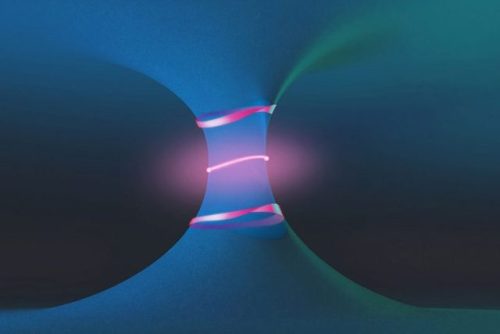Your gateway to endless inspiration
Optics - Blog Posts
Imagine the lightsabers from this

Scientists Observe New Exotic Phenomena in Photonic Crystals
Topological effects, such as those found in crystals whose surfaces conduct electricity while their bulk does not, have been an exciting topic of physics research in recent years and were the subject of the 2016 Nobel Prize in physics. Now, a team of researchers at MIT and elsewhere has found novel topological phenomena in a different class of systems — open systems, where energy or material can enter or be emitted, as opposed to closed systems with no such exchange with the outside.
This could open up some new realms of basic physics research, the team says, and might ultimately lead to new kinds of lasers and other technologies.
The results are being reported this week in the journal Science, in a paper by recent MIT graduate Hengyun “Harry” Zhou, MIT visiting scholar Chao Peng (a professor at Peking University), MIT graduate student Yoseob Yoon, recent MIT graduates Bo Zhen and Chia Wei Hsu, MIT Professor Marin Soljačić, the Francis Wright Davis Professor of Physics John Joannopoulos, the Haslam and Dewey Professor of Chemistry Keith Nelson, and the Lawrence C. and Sarah W. Biedenharn Career Development Assistant Professor Liang Fu.
Read more.
Rithmatics: Part 8, Intro to Lines of Vigor
Let's start with what we know for sure from the books:
Lines of Vigor can only affect chalk creations
You have to draw at least two waveforms to shoot a Line of Vigor
Lines of Vigor can damage or move Lines of Warding (and other chalk creations)
"smaller curves" are stronger [1]
A "large arc" lets them move other lines [2]
Lines of Vigor can bounce off of Lines of Forbiddance
We have previously established that the source of the illustrations in the book is playing fast and loose with the definition of curvature, so the notions of "smaller" and "larger" in the above are not entirely clear. I know what I want them to mean though...
Theory Time
You know what this sounds like to me? This sounds like electromagnetic waves. EM waves are often modeled with transverse waves (the sine curves all of our examples of LoV look like are transverse waves). Higher frequency radiation, such as UV rays is better at penetration than lower frequency radiation, like infrared. Infrared, on the other hand, is much better at transferring energy, which could very reasonably lead to a transfer of momentum here and thus lead to things moving. As long as velocity is constant, frequency and wavelength are inversely proportional. This means that the tighter the curve is the higher the frequency. Theory: Lines of Vigor are based on EM waves.
Possible Implications:
A EM wave with a larger amplitude has more energy. This would suggest that a Line of Vigor with a short wave length and high amplitude would be better at punching through things and one with the same wavelength and small amplitude. The effect could be even more pronounced with high amplitude long wave length waves that are trying to push things around
EM waves follow the law of superposition - if you stack two on top of each other you can add them at every point to get a new wave. This would suggest that there might be more interesting LoV. Instead of just sin(x), we could get things like sin(x)+sin(x/2). The more complicated ones could be tricky to get right, but might be able to do interesting things.
Related to the previous point, you could get interesting effects if LoV could have interference patterns like EM waves do...
EM waves travel with different speeds through different materials and you get refraction when they move between materials. Since LoV only affect chalk, it is possible they are only affected by chalk, but if the material they move across affects their velocity, you could get refracted LoV when they move from the sidewalk to the asphalt.
Lines of Forbiddance would be playing the role of mirrors. I have lots of ideas here, but those are for a future post or this one will end up ridiculous.